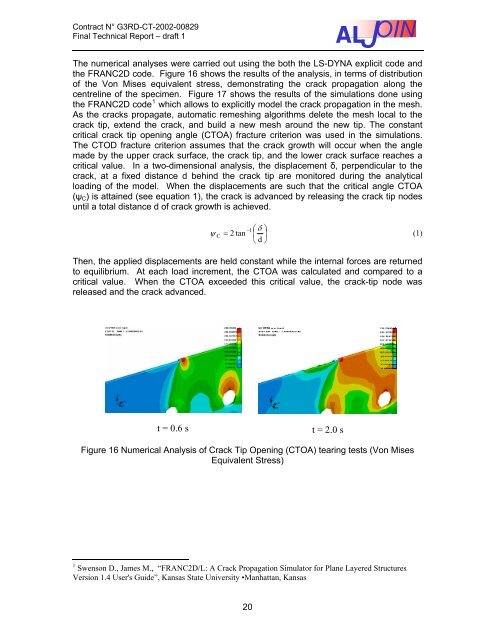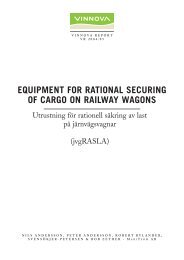ALJOIN Final Technical Report - Transport Research & Innovation ...
ALJOIN Final Technical Report - Transport Research & Innovation ...
ALJOIN Final Technical Report - Transport Research & Innovation ...
You also want an ePaper? Increase the reach of your titles
YUMPU automatically turns print PDFs into web optimized ePapers that Google loves.
Contract N° G3RD-CT-2002-00829<br />
<strong>Final</strong> <strong>Technical</strong> <strong>Report</strong> – draft 1<br />
<strong>ALJOIN</strong> The numerical analyses were carried out using the both the LS-DYNA explicit code and<br />
the FRANC2D code. Figure 16 shows the results of the analysis, in terms of distribution<br />
of the Von Mises equivalent stress, demonstrating the crack propagation along the<br />
centreline of the specimen. Figure 17 shows the results of the simulations done using<br />
the FRANC2D code 1 which allows to explicitly model the crack propagation in the mesh.<br />
As the cracks propagate, automatic remeshing algorithms delete the mesh local to the<br />
crack tip, extend the crack, and build a new mesh around the new tip. The constant<br />
critical crack tip opening angle (CTOA) fracture criterion was used in the simulations.<br />
The CTOD fracture criterion assumes that the crack growth will occur when the angle<br />
made by the upper crack surface, the crack tip, and the lower crack surface reaches a<br />
critical value. In a two-dimensional analysis, the displacement δ, perpendicular to the<br />
crack, at a fixed distance d behind the crack tip are monitored during the analytical<br />
loading of the model. When the displacements are such that the critical angle CTOA<br />
(ψC) is attained (see equation 1), the crack is advanced by releasing the crack tip nodes<br />
until a total distance d of crack growth is achieved.<br />
−1⎛<br />
δ ⎞<br />
ψ C = 2 tan ⎜ ⎟<br />
(1)<br />
⎝ d ⎠<br />
Then, the applied displacements are held constant while the internal forces are returned<br />
to equilibrium. At each load increment, the CTOA was calculated and compared to a<br />
critical value. When the CTOA exceeded this critical value, the crack-tip node was<br />
released and the crack advanced.<br />
t = 0.6 s<br />
t = 2.0 s<br />
Figure 16 Numerical Analysis of Crack Tip Opening (CTOA) tearing tests (Von Mises<br />
Equivalent Stress)<br />
1 Swenson D., James M., “FRANC2D/L: A Crack Propagation Simulator for Plane Layered Structures<br />
Version 1.4 User's Guide”, Kansas State University •Manhattan, Kansas<br />
20

















